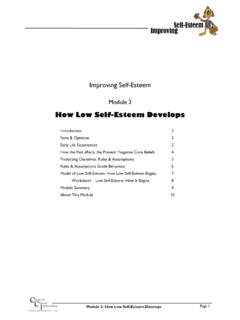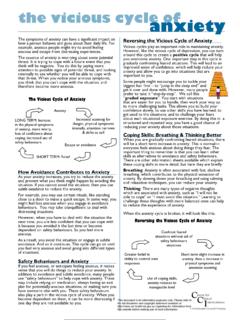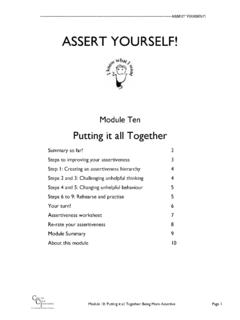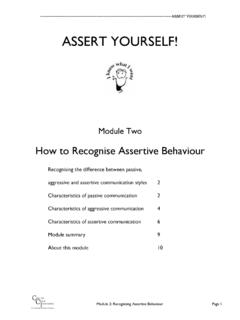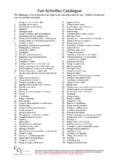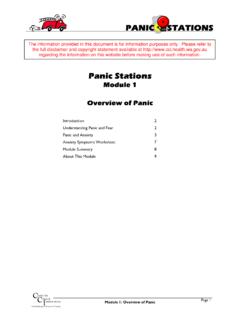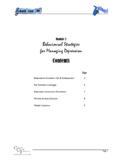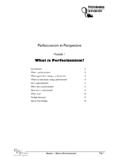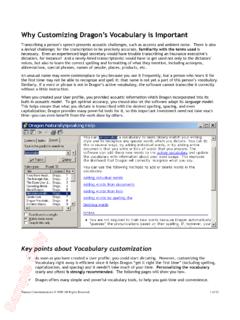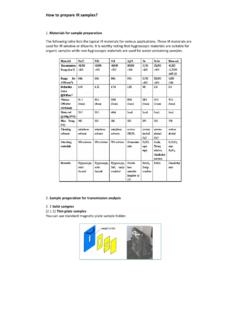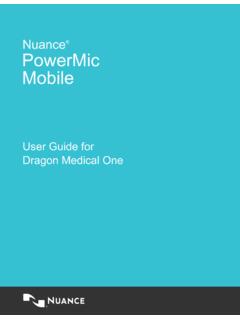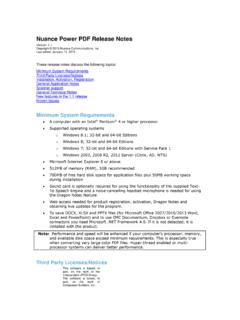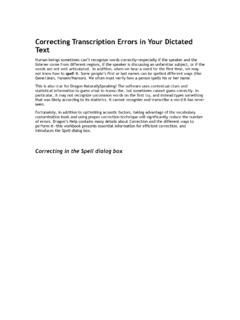Transcription of SE Module 8 July 05 - WA Health
1 ImprovingSelf-EsteemPage 1 Psychotherapy Research TrainingCCIentre forlinicalnterventionsModule 8: Developing Balanced Core BeliefsImproving Self-EsteemModule 8 Developing Balanced Core BeliefsIntroduction2 Identifying Your Negative Core Beliefs2 Adjusting Your Negative Core Beliefs4An Ongoing Process8 Adjusting Your Negative Core Beliefs (Example)9 Worksheet: Adjusting Your Negative Core Beliefs10 Module Summary11 About This Module12 ImprovingSelf-EsteemImprovingSelf-Esteem Page 2 Psychotherapy Research TrainingCCIentre forlinicalnterventionsModule 8: Developing Balanced Core BeliefsIntroductionWe have now come to the final step in tackling low self-esteem changing the negative core beliefs youhave about yourself. In earlier modules, you learned how to tackle the negative unhelpful thoughts youmight have in day-to-day situations, which sprout from your negative core beliefs. In Module 7, you learnedhow to change the unhelpful rules and assumptions that have kept your negative core beliefs intact.
2 All ofthese previous modules have put you in a strong position to now directly tackle the negative core beliefsthat are at the root of your low self-esteem. All the hard work you have done so far has been underminingyour negative core beliefs, shaking the ground beneath them, and sowing the seed of doubt as to howaccurate they are. So let s finish the job, and focus on adjusting those negative core beliefs from negativeand biased, to balanced and Your Negative Core BeliefRemember, your negative core beliefs reflect the negative, broad, and generalised judgements you havemade about yourself, based on some negative experiences you might have had during your earlier on the work you have done in the earlier modules, you may already know what those beliefs are andyou may have begun to question them. However, let s really focus on this you are not clear as to what your negative core beliefs are as yet, you need to first pin them down andidentify them, before you can start changing them.
3 Reflecting on the work you have already done willprovide information and clues as to what your negative core beliefs are. To uncover those negative corebeliefs, you will need to think about the implications of the specific clues and information you alreadyhave, that is, think about what they say about the overall view you have of yourself. Importantquestions to ask yourself throughout this identification process are: What does thisinformation mean about me as a person? What does this clue say about who I am? Askingyourself these questions will help you uncover your negative core beliefs from specificthoughts and experiences you have already are the various clues and information you can use to identify your negative core beliefs. Go througheach of them, and see if you can discover the specific negative core beliefs that ring true for Life ExperiencesThe negative life experiences that you identified in Module 2 as contributing to the development of yourlow self-esteem could provide clues as to what your negative core beliefs are.
4 Reflect on these experiencesand ask yourself the following questions. Jot down any ideas about the negative core beliefs that come tomind. Did these experiences lead me to think there was something wrong with me in some way? Ifso, what was wrong? Do I remember specific situations that accompany the negative thoughts or feelings I haveabout myself? What do my memories of these situations say about me as a person? Can I link a specific person I know to the way I feel about myself? Has that person usedcertain words to describe me? What does their treatment of me say about me as a person?ImprovingSelf-EsteemPage 3 Psychotherapy Research TrainingCCIentre forlinicalnterventionsModule 8: Developing Balanced Core BeliefsBiased ExpectationsThe biased expectations that you identified in Module 4 could provide some ideas as to what your negativecore beliefs are. Reflect on the key concerns you identified in your Thought Diaries for biasedexpectations, and ask yourself the following questions.
5 Jot down any ideas about the negative core beliefsthat come to mind. If my biased expectations were to come true, what would that mean about me as a person? If I didn t avoid or escape or use my safety behaviours, what would I be worried aboutrevealing to other people about who I am?Negative Self-EvaluationsThe negative self-evaluations you uncovered in Module 5 will also provide clues regarding your negativecore beliefs. Think about the sorts of criticisms you made of yourself in your Thought Diaries for negativeself-evaluations, and ask yourself the following questions. Jot down any ideas about the negative corebeliefs that come to mind. What do my negative self-evaluations say about me as a person? What are the common themes, labels, words, or names I use to describe myself? What dothey mean about me? Do my negative self-evaluations remind me of criticisms I have received from others when Iwas young? What do those criticisms tell me about myself?
6 What things make me critical of myself? What do these things say about who I am?Difficulties Promoting Balanced Self-EvaluationsThe difficulties you may have had in Module 6 with focusing on the positive you (by writing down yourpositive qualities) and acting like the positive you (by doing pleasant activities that are just for yourself) maygive you some ideas regarding your negative core beliefs. Reflect on any troubles you had with thinkingabout yourself kindly and treating yourself kindly, and ask yourself the following questions. Jot down anyideas about the negative core beliefs that come to mind. What made it difficult to think about myself kindly or treat myself kindly? What was I telling myself when I tried to do these things? What do my reactions to thinking/treating myself well tell me about how I see myself?ImprovingSelf-EsteemPage 4 Psychotherapy Research TrainingCCIentre forlinicalnterventionsModule 8: Developing Balanced Core BeliefsPerceived Outcomes Of Not Fulfilling The RulesIn Module 7, you clearly identified your unhelpful rules and assumptions.
7 You can also use these to uncoveryour negative core beliefs. Think about what you fear will happen if your rules are broken. Sometimesyour rule will incorporate the negative core belief (eg., If I don t do things perfectly, I am incompetent, Ifpeople see the real me, then they will know I am inferior, If I disappoint someone, then I am a badperson. ). Ask yourself the following question and jot down any ideas about the negative core beliefs thatcome to mind. If my rule was broken, then what would that mean about me?Using all of the above clues and asking yourself what these things tell you about how you see yourself willhelp you to uncover your negative core beliefs. Once you think you have a clear idea as to what they are,write them down in the space Your Negative Core One Negative Core BeliefIf you have identified a number of negative core beliefs, choose only ONE to begin working on. You couldchoose the one that is of greatest concern to work on now or one that is related to any biasedexpectations, negative self-evaluations, or unhelpful rules and assumptions that you have previously workedon.
8 Write that negative core belief in the top box of the Adjusting Core Beliefs Worksheet on page note how much you believe the negative core belief at now, when it s most convincing, and when it sleast convincing. Note how the negative core belief makes you feel. Throughout this Module , you willneed to keep referring to this worksheet and completing the relevant sections as we go. This will ensurethat as you work through your negative core belief and tackle it, you have a clear record of this process torefer to at anytime in the future. There s an example of how to complete the worksheet on page you have worked through the process of adjusting this first negative core belief, you will then be ableto apply it to other negative core beliefs you might want to a Balanced Core BeliefNow it s time to develop an alternative core belief to replace your old negative one. When developing anew core belief, you want to aim for something that is more positive, balanced, and realistic.
9 Think ofsomething that is a more accurate reflection of yourself. It is important that the work you do on yournegative core beliefs is not just about squashing the belief that you have been carrying around, but alsoImprovingSelf-EsteemPage 5 Psychotherapy Research TrainingCCIentre forlinicalnterventionsModule 8: Developing Balanced Core Beliefsabout promoting a new balanced view of yourself. So it is not so much about saying what you are not (eg., I am not stupid ), but more about saying what you are (eg., I am capable in many ways ).From the work you have done in previous modules, you may already have some idea of what a morebalanced core belief might be. It might be the opposite to your old belief (eg., I am incompetent I amcompetent ), a more moderate view of yourself (eg., I am a failure I am great at many things, averageat other things, and weaker in some areas like anyone else ), or something else (eg., I am no good Iam a worthwhile person ).
10 The important thing is that the new belief is more balanced, weighing up all theinformation (not just the negative) available, and including both your strengths and weaknesses. Whendeveloping a new core belief, ensure that your worth as a person is not being determined by only yourfaults or weaknesses. Also make sure that you are not painting an overly positive view of yourself (eg., Iam perfect in everyway ), as this will be unrealistic, and it is unlikely that you will believe it. Remembernot to discount any new alternative core beliefs on the basis that you don t fulfil these 100% (eg., I can tput down that I am competent because sometimes I get things wrong. ). No one is capable of such feats ofperfection, so instead, accept that you are your new view of yourself not perfect, but good enough. Now that you have an idea of your new balanced core belief, write it in the Adjusting Negative CoreBeliefs worksheet on page 10. Also note how much you believe this new core belief at various times(now, when it is most convincing, and when it is least convincing) and how it makes you feel when youreflect on it.
